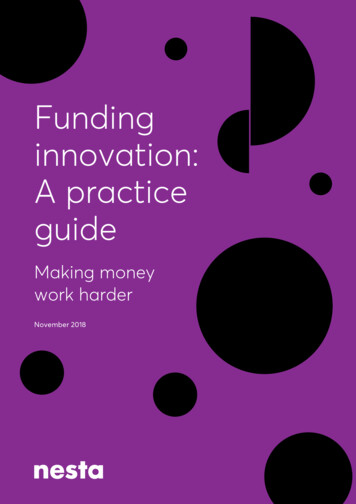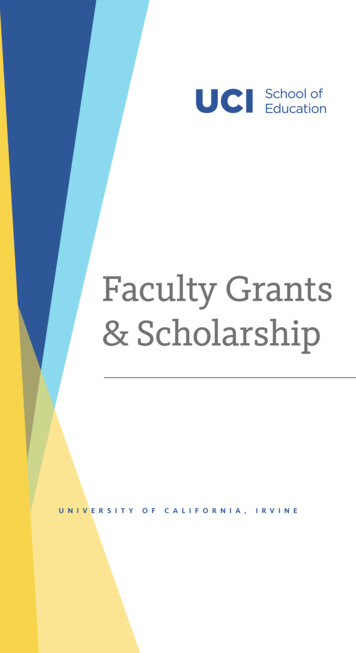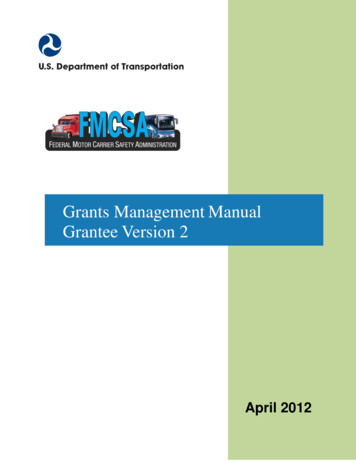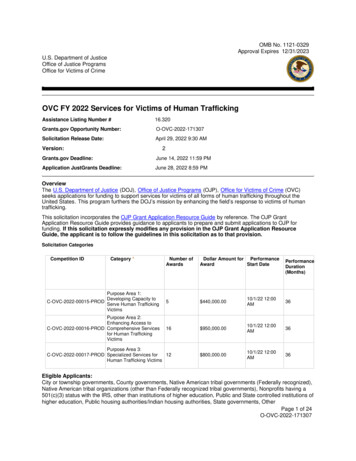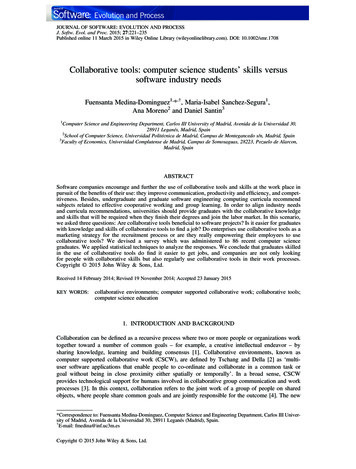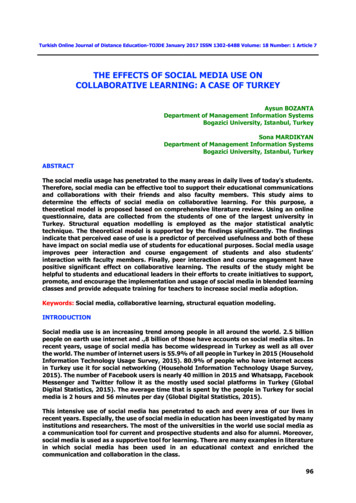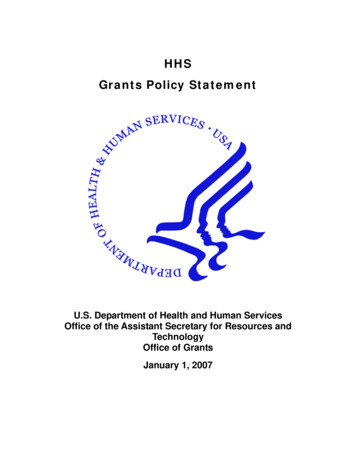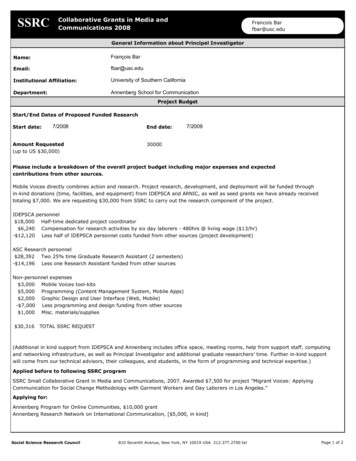
Transcription
SSRCCollaborative Grants in Media andCommunications 2008Francois Barfbar@usc.eduGeneral Information about Principal InvestigatorName:François BarEmail:fbar@usc.eduInstitutional Affiliation:University of Southern CaliforniaDepartment:Annenberg School for CommunicationProject BudgetStart/End Dates of Proposed Funded ResearchStart date:7/2008End date:Amount Requested(up to US 30,000)7/200930000Please include a breakdown of the overall project budget including major expenses and expectedcontributions from other sources.Mobile Voices directly combines action and research. Project research, development, and deployment will be funded throughin-kind donations (time, facilities, and equipment) from IDEPSCA and ARNIC, as well as seed grants we have already receivedtotaling 7,000. We are requesting 30,000 from SSRC to carry out the research component of the project.IDEPSCA personnel 18,000 Half-time dedicated project coordinator 6,240 Compensation for research activities by six day laborers - 480hrs @ living wage ( 13/hr)- 12,120 Less half of IDEPSCA personnel costs funded from other sources (project development)ASC Research personnel 28,392 Two 25% time Graduate Research Assistant (2 semesters)- 14,196 Less one Research Assistant funded from other sourcesNon-personnel expenses 3,000 Mobile Voices tool-kits 5,000 Programming (Content Management System, Mobile Apps) 2,000 Graphic Design and User Interface (Web, Mobile)- 7,000 Less programming and design funding from other sources 1,000 Misc. materials/supplies 30,316TOTAL SSRC REQUEST(Additional in kind support from IDEPSCA and Annenberg includes office space, meeting rooms, help from support staff, computingand networking infrastructure, as well as Principal Investigator and additional graduate researchers’ time. Further in-kind supportwill come from our technical advisors, their colleagues, and students, in the form of programming and technical expertise.)Applied before to following SSRC programSSRC Small Collaborative Grant in Media and Communications, 2007. Awarded 7,500 for project "Migrant Voices: ApplyingCommunication for Social Change Methodology with Garment Workers and Day Laborers in Los Angeles."Applying for:Annenberg Program for Online Communities, 10,000 grantAnnenberg Research Network on International Communication, [ 5,000, in kind]Social Science Research Council810 Seventh Avenue, New York, NY 10019 USA 212.377.2700 telPage 1 of 2
SSRCCollaborative Grants in Media andCommunications 2008Francois Barfbar@usc.eduReveived:Annenberg Program for Online Communities, 4,000 seed grantSSRC, 3,000 carry over from Small Collaborative GrantAnnenberg Research Network on International Communication, [ 5,000, in kind]Letter(s) of Support from Partner Organization(s)OrganizationAddressInstituto de Educacion Popular del Sur de California (IDEPSCA)Main ContactAmanda Garces - agcolombia@gmail.com1565 W. 14th St,Los Angeles, CA 90015 USASubmission InformationDigitally signed and submitted bySocial Science Research Councilat810 Seventh Avenue, New York, NY 10019 USA 212.377.2700 telPage 2 of 2
MOBILE VOICES: PARTICIPATORY ACTION RESEARCH FOR MOBILE COMMUNITYAMONG IMMIGRANTS IN LOS ANGELESPROJECT OVERVIEWMobile Voices is an academic-community partnership to research and design a platform for lowwage immigrants in LA to publish stories about their lives and their communities directly from theirmobile phones. This low-cost, open source, customizable, and easy to deploy multimedia mobilestorytelling platform will be designed in collaboration with its users, and will help recent immigrants wholack computer access gain greater participation in the digital public sphere. In parallel, our research teamwill study and document participatory approaches to building and deploying low-cost new media, explorehow storytelling helps community building and organizing, and investigate how emerging media toolscan best be leveraged to promote digital inclusion and assist marginalized groups. Our research outputswill include a case study on participatory technology design; pre- and post- evaluations of communicationskills and practices among the partner community; a mobile-customized version of the popular free andopen source content management system Drupal; a free and open source application for low-cost mobilehandsets; a systematic review of existing mobile services for organizing and advocacy efforts; a populareducation toolkit for grassroots mobile organizing; and a participatory evaluation of the project's impact.Project partners: Mobile Voices is a collaboration between the Annenberg Research Networkon International Communication at the Annenberg School for Communication, University of SouthernCalifornia (ARNIC - http://arnic.info), and the Institute of Popular Education of Southern California(IDEPSCA - http://idepsca.org), a nonprofit serving low-income Latino immigrants in Los Angeles.IDEPSCA runs six day laborer centers under contract with the City of Los Angeles, organizes daylaborers at corners throughout the city, and offers health programs, a domestic worker organizing project,and an elementary school. Research team members have experience with technology-based and opensource media projects (including Indymedia, FilmAid International, and the Chiapas Media Project), andwe are drawing on USC colleagues for specialty programming talent. In addition, we are receiving expertadvice from Prof. Abel Valenzuela at UCLA (an expert on issues faced by minorities and immigrants in1
the U.S.), from the creators of Zexe.net (a network of collectives reporting from cell phones),Mologogo.com (a location aware social application), and technical experts at UC San Diego.Target participants/audience and distribution plan: The primary target participants andaudience are low-wage immigrant workers and the community-based organizations that work with them,beginning with IDEPSCA and day laborers in LA. At a later stage, the project will expand to additionalcommunity-based organizations in LA. We have begun building relationships with community-basedorganizations that work with other immigrant communities in LA, in anticipation of future project rolloutbeyond IDEPSCA. This includes organizations that work with LA’s Korean, Pilipino, and South Asiancommunities. Beyond that, the target is any community where the mobile phone is the primary means oftwo-way communication. These groups of people will gain access to a free, open source, mobilestorytelling platform, as well as training materials on how to use it. Researchers, ICT4D projects, andtechnology designers are a secondary target, and will be able to learn from our experience in participatorytechnology design, deployment, and evaluation. Our project's tools will be distributed via our ties toprogressive funders that support community-based organizations around the country, such as FundingExchange partners. Our research findings will be disseminated via academic publications, conferencepresentations, and via the ARNIC network. Both our toolkit and research reports will be circulated amongthe ICT4D community, for example through the ARNIC website as well as through our ties to theAssociation for Progressive Communications, the Global Knowledge Partnership, LIRNE Asia, andDIRSI. We will also contribute regularly to the popular mobile activism blog http://mobileactive.org.Finally, our ties to the Journalism department at the Annenberg School of Communication will help usamplify project stories and visibility in the mass media (print and broadcast).Background: Mobile Voices comes out of an ongoing, two-year effort to use Communication forSocial Change methodology to analyze the political, technical, and organizing needs of innovativemultiethnic media projects controlled by low-wage immigrant workers in Los Angeles. This participatorycommunication project has been focused on, first, strengthening internal, intragroup, and externalcommunication channels among Los Angeles' low-wage immigrant populations, second, developing2
specific and appropriate technology solutions in this context, and third, carefully documenting theresearch process and the tools developed in order to make them available to others for adaptation andlocal re-use. Our project team's initial research, supported by the SSRC's Small Collaborative Grantsprogram in 2007, mapped the communication ecology of low-wage immigrant worker organizations inLA and, through interviews, surveys, and a participatory production workshop, identified audio (radio andCD) and mobile phones as the two most important communication tools for the community partners. Thatstage of work produced a strategic communication plan for community partners as well as an ongoingaudio production workshop, two CDs worth of audio material, worker-created and administered surveys,and other outputs. Additional information about that stage of research, including a summary of thecontext and conditions for low-wage immigrant workers in LA, is available from the Small CollaborativeGrant description at the SSRC 's Media Research Hub.1THE MOBILE VOICES RESEARCH PLANThe Mobile Voices project will proceed in three stages over a one-year period, from July 2008 toJuly 2009, with distinct research activities at each stage to assess the project’s process and impact.1. Prototyping (June, July, August): Our project team, including communication researchers,engineers, software developers, community organizers, and day laborers will work together to build asystem based on the usage and design needs of the day laborers. We will develop and test a mobilestorytelling platform that allows participants to take pictures and record audio, tag these with descriptions,and upload them to the Mobile Voices content management system (CMS). Participants will also be ableto display and track their location on a map, and access all Mobile Voices content either from a phone orcomputer. Our preliminary surveys and conversations with day laborers highlight the potential of aparticipatory design approach: workers have already suggested specific applications, such as using thephone’s GPS to find their way when they are driven to unfamiliar work sites or taking work site pictures1 See ionfor-social-change-methodology.3
before and after their workday to document their labor. In this stage, the research team will focus onparticipatory design methods, producing a paper that reviews participatory design literature anddocuments our experience in this case. At this point we will also be conducting a baseline study ofcommunication practices among day laborers.2. Deployment (September-December 2008): Once the system is working, the initial designparticipants will train others at each of IDEPSCA's six centers, who will in turn train 5 to 10 moreparticipants each, thereby building the Mobile Voices community. By the end of this stage, there will be30-60 people publishing stories directly from their phones to the Mobile Voices platform, producing aregular stream of fresh content and meeting periodically to make editorial decisions, plan outreach, andconduct training. In this stage, the researchers will examine whether mobile storytelling serves to buildand strengthen community, producing a case study on the potential of affordable mobile phones to aiddigital inclusion. At this time the project team will also be developing written and visual trainingmaterials for use in the trainings and for translation and packaging in the Mobile Voices toolkit.3. Diffusion (January-June 2009): In the third stage, the Mobile Voices project will expand toother immigrant communities in LA, as participation and training are opened to additional communitybased organizations that focus on low-wage immigrant workers. The project will gain increased visibilityas we transfer the Mobile Voices platform to other contexts. We will also work with the ethnic andmainstream media to feature stories on the project, and we will tap into a number of resources available atthe Annenberg School in our efforts to connect with media outlets. Our mobile storytelling platform willsupport a variety of community building applications, from storytelling that helps make marginalizedpeople visible, to community journalism, to practical ways of increasing job opportunities (i.e. a mobilelabor market, described below). In this stage, research will focus on issues that arise in the attempt todeploy our platform and trainings across a variety of community building projects. We will conduct aparticipatory project evaluation, as well as a study of day laborer communication practices to compare tothe baseline study. We will also finalize the toolkit at the end of this stage.Further Applications and Outreach: In addition to the participatory design case study, the4
baseline study, and the 1-year project evaluation study, deliverables will include the Mobile Voicescontent management system, mobile handset application, and a toolkit for use by community-basedorganizations that want to participate in Mobile Voices or set up their own innovative mobile phonebased participatory journalism project. The toolkit will be available under a creative commons license,both as a booklet with CD and for free download as a disk image and .pdf. It will include an overview ofmobile journalism and advocacy applications, a map of available mobile service providers, a checklist ofmobile applications according to ease of use, cost, privacy, licensing, scalability, and other requirements,a tutorial for installation and customization of the Mobile Voices CMS and handset applications, and apopular education style training manual for community-based organizations. We hope to use this toolkitto provide trainings to a number of additional community-based organizations in LA, including theGarment Worker Center, Koreatown Immigrant Worker Alliance, Pilipino Worker Center, and SouthAsia Network. Ideally these and additional groups will join the Mobile Voices project, moving us closerto the goal of a citywide, mobile, multiethnic, immigrant communication network. We also envision theMobile Voices materials being useful in a wide range of contexts, including developing country locationswhere mobile phones anre the primary means of communication.Work already completed: The Mobile Voices project has already begun. We have conductedsurveys with 43 day laborers at IDEPSCA day laborer centers across the city. We asked laborers abouttheir experiences with mobile phones, what they most often use their phones for, and if they would beinterested in participating in a mobile phone project. For example, we learned that almost 80% currentlyown mobile phones and most use their phones primarily for work purposes. A majority of workersexpressed interest in receiving messages from IDEPSCA on their mobile phones (including jobs, eventannouncements, health information, and news), as long as they would not be charged for the messages.This exploratory data will help us determine what types of phones day laborers have the most experiencewith, which service providers they have had difficulties with, and how to best develop a project that willfacilitate their storytelling participation while still meeting essential communication needs.In addition, we have already worked with engineering students at USC to develop two prototype5
java-based mobile phone applications that will serve as a starting point for participatory design workshopswith workers. The first application implements a straightforward blogging platform on mobile phones,and the second supports a ‘mobile job market’ in which workers’ skills and availability are matched tocontractors’ needs. We have also begun work on the Content Management System, a customized build ofthe popular open-source CMS Drupal. We coordinate and document our development efforts openlythrough the Indymedia Documentation Project at THESES & RESEARCH QUESTIONSThe research component of Mobile Voices is designed to test three core hypotheses, eachassociated with a set of research questions.H.1: Participatory design yields successful appropriation of mobile media and generatesapplications that better serve the user communityWhile several Mobile Voices features are available in various ready-made commercialapplications, our working hypothesis is that it is worth engaging in a participatory process with those whowill use the application and study what constitutes successful appropriation of mobile telephony for socialchange. We believe this process to be productive for several reasons. First, we expect the collaborativeinteraction between users and designers to result in a better articulation of the needs of immigrants,allowing us to craft the application’s architecture to respond to these unique needs (for example, to buildin strong privacy protection). Second, we expect the participatory process to be an empowering one forparticipants, building capacity and improving technical and media literacy. And third, we expectparticipatory design to lead to greater use and deeper engagement with storytelling practices.H.2: Storytelling is an effective practice for community buildingOur ultimate goal is to understand whether accessible ICT tools such as mobile phones allow agroup of users to build stronger community ties and to improve their lives. Our hypothesis is that activeparticipation in the storytelling process is a particularly effective way to do that. The literature oncommunity storytelling and media effects shows that the way in which a community is portrayed in the6
media influences internal and external perceptions and in turn affects levels of civic engagement (Kim etal., 2006, Matei et al., 2005). When the link between residents and traditional media is fairly weak (as isthe case with immigrant day laborers), a direct storytelling contribution cultivated within the communitycan provide different perspectives and disseminate information about vital community resources.Storytelling opportunities provided by Mobile Voices will help groups of immigrants better articulatetheir concerns, and, as a result, be better positioned to develop strategies for action. In addition, beyondthe benefits within the community, we anticipate that stories emerging from Mobile Voices will be pickedup by blogs and mass media, promoting greater awareness and more open dialogue in the public sphere.H.3: Mobile phones and open-source content management platforms are effective generictools for digital inclusionMobile Voices intends to develop a storytelling platform that combines affordable mobile phonesand a Free, Open-Source Software (F/OSS) content management system. This will allow us to studywhether and how a F/OSS platform for mobile content publishing and networking can provide aneffective tool for community building, participatory journalism, and for bridging the 'participatory divide'.Our assumption in doing so is that mobile phones can serve as an entry point for people who have no orlimited access to computers. We expect that the collective assembly of stories built around the mediamaterials collected with mobile phones will facilitate greater computer literacy, and the platform will bedesigned with this in mind. An additional hypothesis is that designing digital tools that are generic andopen-source will facilitate their use and adaptation in a variety of community contexts.RESEARCH METHODSMobile Voices research involves multiple methods to analyze and assess the various dimensionsof the project. A key characteristic of our project and research methodology is that action and research aretightly integrated and will be conducted jointly by IDEPSCA and USC researchers. IDEPSCA staff andday laborers will be trained to participate in the evaluation (outcome mapping, carrying out surveys, focusgroup discussions, etc) and will therefore be directly involved not only in the project’s design and7
implementation, but also its assessment.1. Usage Surveys. We have begun to conduct a detailed baseline survey to understand phone usagepatterns among day laborers. We plan to conduct periodic follow up surveys to assess changes inusage patterns and evaluate the project’s impact on phone usage.2. Participatory design. We will conduct workshops and focus group discussions involving daylaborers, researchers, and designers to set the application parameters and define the platform’sarchitecture. Software engineers will build prototypes on the basis of these conversations, to berefined through follow- up sessions. Researchers will observe the process to assess its success andsuggest improvements. We have already held one such session and now have two initialprototype handset applications.3. Participatory journalism. We will conduct regular multimedia storytelling workshops with daylaborers, during which we will jointly review the multimedia materials they capture, organizethese materials, and publish stories on-line and through IDEPSCA’s newsletter, and strategizearound subsequent reporting activities. Researchers will be participant observers during thesemeetings, to document and evaluate the process and its impact. Another impact of the project willbe the extent to which participants' voices are amplified by established media outlets. To assessthese outcomes, we will monitor independent, ethnic, and mainstream media for stories seeded byMobile Voices and for coverage of our project. Traffic to the Mobile Voices website will also bemonitored and analyzed.4. Outcome mapping and change assessment. At key stages in the project, we will conductOutcome Mapping / Most Significant Change exercises involving all key stakeholders (daylaborers, IDEPSCA staff, and researchers). These sessions will serve to develop meaningfulindicators that will be used to measure the project’s outcomes and impact.5. Replicability and sustainability. We will track adoption of the mobile tools by otherorganizations/groups in LA and elsewhere, and contact them to assess its adaptability to diversecontexts as well as the sustainability of the tool and practices built around it.8
RESEARCH RELEVANCEFrom a practical standpoint, Mobile Voices will contribute to a better understanding of thepotential of low-cost mobile phone technologies for digital inclusion. This project gives voice to lowincome immigrants, whose viewpoints are often absent from mainstream media coverage and onlinediscussion forums. This is significant at four levels: immigrants are empowered by an increased ability totell their stories; community organizations gain better ways to communicate internally with members andexternally with stakeholders; novel participatory approaches are cultivated; and the broader LAcommunity and mainstream media benefit through better representation of diverse viewpoints.Many other projects provide disenfranchised communities with computers to help them tell theirstories. Mobile Voices is different because it starts with the mobile phones that immigrants are alreadyfamiliar with and teaches them to use all the phones' features to produce stories. Some projects use mobilephones, but prefer high-end, expensive devices, and impose ready-made applications for their target users.By contrast, Mobile Voices will explore the use of low-cost pre-paid phones such as Motorola's i855e:under 100, it comes with camera, voice recorder, mp3 support, GPS, and unlimited data service for 10/month. Motorola has fully opened the phone's Java interface, enabling us to work with users todesign multimedia, integrated, open applications that fit their needs.From a theoretical standpoint, the Mobile Voices project contributes primarily to threeestablished research areas, and explores the linkages among them: Information and CommunicationTechnology for Development (ICT4D), Communication for Social Change (CFSC), and ParticipatoryDesign and Research. ICT4D research has traditionally focused on information transmission and itseffects (Heeks, 2007), technology adoption (Donner, 2003), and more recently, user-driven innovationand appropriation (Bar et al., 2007). Recent work has increasingly acknowledged the unpredictability ofICT impact due to the uncontrollable variety of factors that influence human interaction with technologyand the resulting social change. Critics of traditional ICT4D evaluation approaches also argue that the “C”in ICT4D is often underemphasized or undervalued and that the communication process, as well as otherkinds of capacity building, cannot be fully measured or appreciated using solely quantitative, expert-9
driven methods (Ramírez, 2007; Gumucio-Dagron & Tufte, 2006). Furthermore, research on mobilephone use among low-income populations in the developing world has found that the social benefits ofmobile telephony are frequently viewed by users as more important than the economic benefits (Donner,2005; Horst & Miller, 2006); studies in a variety of contexts have found correlations between mobilephone use and enhanced social capital (Ling, 2004; Sugiyama & Katz, 2003).At the other end of the spectrum, communication for social change, community organizing, andadult education projects have favored a more community-driven, horizontal, and cyclical learningapproach to program design and evaluation. The increasingly popular and varied range of participatoryresearch methods (including evaluation) try to rectify the inherent power imbalance of top-down, expertdriven initiatives. They view community participation as enhancing project relevance and sustainabilitywhile also building the capacity of the community to identify and solve problems.Community-based participatory research can take a ‘hybrid’ approach to design and evaluativeresearch methods, incorporating elements of both ICT4D and CFSC, combining ‘expert’ and ‘local’knowledge, quantitative and qualitative methods, and varying degrees of participation. Building on thestrengths of ICT4D and participatory, Freirian-inspired methodologies, Ricardo Ramírez (2007) hassuggested taking a systems thinking approach, “based on sociotechnical systems, stakeholderengagement, an acknowledgement of the multiple dimensions at play, and the growing evidence ofunpredictability of ICTs.” He suggests several possibilities including identifying indicators through adialogue among all direct stakeholders, outcome mapping (Earl et al. 2001), and “most significantchange” methodology (Dart & Davies, 2003).The Mobile Voices project stands to make a valuable contribution to participatory research aswell as practice with a systematic, self-critical approach that casts a wide enough net to captureunexpected outcomes, whether positive or negative. In these ways the collaboration will not only lead tothe production of innovative technology for community organizing and individual empowerment, but willproduce cutting-edge research on participatory technology design, implementation and evaluation.10
BibliographyAl-Kodmany, K. (2001). Bridging the gap between technical and local knowledge: tools for promotingcommunity-based planning and design. Journal of Architectural and Planning Research, 18(2),110-130.Anderson, B. (1991). Imagined communities. New York: Verso Books.Ball-Rokeach, S. J., Kim, Y.-C. & Matei, S. (2001). Storytelling neighborhood: Paths to belonging indiverse urban environments. Communication Research, 28 (4), 392-428.Bar, F., Pisani, F., and Weber, M. (May 15, 2007 draft). Mobile technology appropriation in a distantmirror: baroque infiltration, creolization and cannibalism. Draft prepared for discussion at theSeminario sobre Desarrollo Económico, Desarrollo Social y Comunicaciones Móviles enAmérica Latina. Convened by Fundación Telefónica in Buenos Aires, April 20-21, 2007.Bell, Thomas (2006). Village computing: a state of the field. Grameen Foundation.Byrne, E., & Alexander, P. M. (2006). Questions of ethics: participatory information systems research incommunity settings. Proceedings of the 2006 annual research conference of the South Africaninstitute of computer scientists and information technologists on IT research in developingcouuntries, 117-126.Costanza-Chock, Sasha (2007). Migrant voices: communication for social change with garment workersand day laborers in Los Angeles, Mid-project report to the Social Science Research Council.Dale, R. (1998). Evaluation frameworks for development programmes and projects. Sage PublicationsThousand Oaks.Dart, J. and Davies, R. (2003). A dialogical, story-based evaluation tool: the most significant changetechnique, The American Journal of Evaluation, 24 (2), pp. 137-155.Donner, J. (2003). What mobile phones mean to Rwandan entrepreneurs. In K. Nyiri (Ed.), MobileDemocracy: Essays on society, self and politics (pp. 393-410). Vienna: Passagen Verlag.Donner, J. (2005). The mobile behaviors of Kigali’s microentrepreneurs: Whom they call And why. InK. Nyiri (Ed.), A sense of place (pp. 293-301). Vienna: Passagen Verlag.Donner, J. (2007). The use of mobile phones by microentrepreneurs in Kigali, Rwanda: changes to socialand business networks. Information Technologies and International Development, 3(2), 3-19.Earl ,S., Carden, F. and Smutylo, T. (2001). OUTCOME MAPPING: building learning and reflection intodevelopment programs, Ottawa: IDRC (available at http://www.idrc.ca/en/ev-9330-201-1DO TOPIC.html)Estrella, M. (2000). Learning from change: issues and experiences in participatory monitoring andevaluation. IDRC.Galperin and Mariscal (ed.), Digital poverty: Latin American perspectives. Available Bonina-Lu 12dic.pdfGumucio-Dagron, A. and Tufte, T., Eds. (2006). Communication for social change nthology: historicaland contemporary readings. Communication for Social Change Consortium, Inc.Heeks, Richard (2007, forthcomi
fbar@usc.edu Collaborative Grants in Media and Communications 2008 Reveived: Annenberg Program for Online Communities, 4,000 seed grant SSRC, 3,000 carry over from Small Collaborative Grant Annenberg Research Network on International Communication, [ 5,000, in kind] Letter(s) of Support from Partner Organization(s) Organization Address
